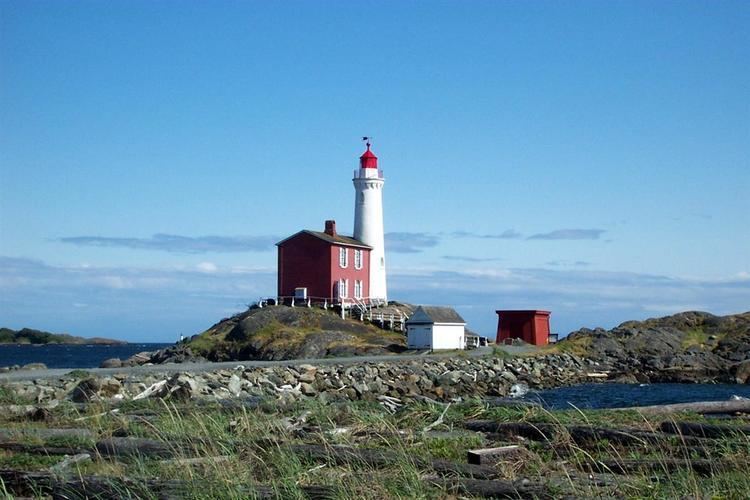Year first constructed 1859–1860 Height 14.6 m (48 ft) Phone +1 250-478-5849 Year first lit 16 November 1860 | Construction bricks tower Automated 1929 | |
 | ||
Location Esquimalt HarbourBritish ColumbiaCanada Tower shape tapered cylindrical tower with balcony and lantern Markings / pattern white tower, red lantern Hours Open today · 10AM–4:30PMSunday10AM–4:30PMMonday10AM–4:30PMTuesday10AM–4:30PMWednesday10AM–4:30PMThursday10AM–4:30PMFriday10AM–4:30PMSaturday10AM–4:30PM Similar Fort Rodd Hill National, Hatley Park National Historic S, Craigdarroch Castle, British Columbia Parliame, Beacon Hill Park Profiles | ||
Historic victoria fisgard lighthouse national historic site
Fisgard Lighthouse National Historic Site, on Fisgard Island at the mouth of Esquimalt Harbour in Colwood, British Columbia, is the site of Fisgard Lighthouse, the first lighthouse on the west coast of Canada.
Contents
- Historic victoria fisgard lighthouse national historic site
- Fort rodd hill and fisgard lighthouse national historic site
- History
- Light and access
- Historical designations
- Keepers of Fisgard Lighthouse
- References
Fisgard Lighthouse is about 10 kilometres (6.2 miles) by boat or 12.5 kilometres (7.8 miles) by car from downtown Victoria. Automated in 1929, the light shows a white isophase light of 2 second period in a sector from 322° to 195° at 21.6 metres (71 ft) above mean sea level, and in other directions it shows red shutters. The white 14.6-metre (48 ft) tower is floodlit below balcony level.
Fort rodd hill and fisgard lighthouse national historic site
History
Fisgard Lighthouse was built in 1860 to guide vessels through the entrance of Esquimalt harbour. It was named after HMS Fisgard, a British Navy ship that spent time in the Pacific..
Fisgard Lighthouse and its sister station Race Rocks Light, were constructed in 1859-60, to ease the movement of naval ships into Esquimalt harbour and merchant ships into Victoria Harbour. The light stations were also seen as a significant political and fiduciary commitment on the part of the British government to the Colony of Vancouver Island, partly in response to the American gold miners flooding into the region: some 25,000 arrived in 1858 for the Fraser gold rush.
Local legend claims that the brick and stone used in construction were sent out from Britain as ballast; in fact local brick yards and quarries supplied these materials, while the lens, lamp apparatus and lantern room were accompanied from England by the first keeper, Mr. George Davies, in 1859. The cast-iron spiral staircase in the tower was made in sections in San Francisco.
Fisgard first showed a light from the tower at sunset on 16 November 1860.
Colonial Governor James Douglas petitioned the British government to build the lighthouse. Captain Richards supported his position. Construction was supervised by Colonial Surveyor and Engineer JD Pemberton. Architects John Wright and Hermann Otto Tiedemann did the design of the lighthouse and the picturesque gothic red brick residence adjoining it.
Permanent steel shutters were added to the landward side of the lantern room some time after 1897, when concussion from the 6-inch guns at newly built Fort Rodd Hill caused cracks to appear in the lantern windows. The last keeper to actually live full-time at Fisgard was George Johnson; Josiah Gosse, Fisgard's final keeper, had permission from the lighthouse authority to live ashore (nearby on Esquimalt Lagoon), and row out to Fisgard every evening.
In the early 1940s, the acetylene lamp in Fisgard's tower was replaced by a battery-powered electric light. In 1950-51, a causeway was built out to Fisgard Island from the foreshore at Fort Rodd Hill by the Canadian Army; this was intended as a military obstacle, but also provided direct access to Fisgard Lighthouse.
Light and access
A causeway from the adjacent Fort Rodd Hill National Historic Site provides access by land.
The former lighthouse keeper's residence is open to the public and contains displays and exhibits about the site's history. The attached tower is not open to the public as it is an operational aid to navigation.
Historical designations
The lighthouse was designated a National Historic Site of Canada in 1958. It is also a Classified Federal Heritage Building.
